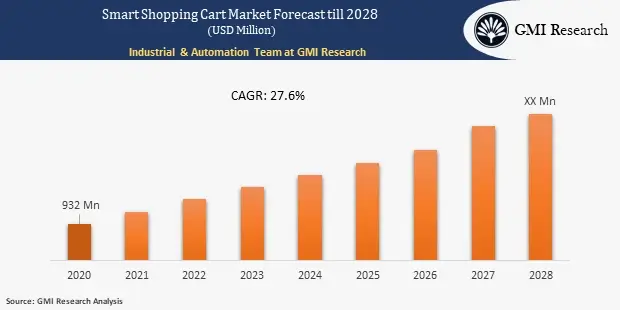General
What benefits are provided by smart carts in the smart shopping carts market?

Imagine entering a supermarket, selecting items, and simply walking out without waiting in line at the cashiers. This convenience is achievable through smart shopping cart technology. Although this technology is relatively recent, stores around the globe have effectively tested it, yielding encouraging results. Smart carts represent the future of the retail industry. In this article, we will explore smart shopping carts and AI checkout systems and delve into their feature and benefits.
Smart Shopping Carts
Unlike the traditional ‘stupid’ shopping carts that merely hold your shopping, smart shopping carts are equipped with sensors such as weight scales, cameras, and barcode scanners. These features allow them to detect the items you select and facilitate seamless payment. In addition, smart shopping carts feature touch screens that display information like prices and allow interactions such as entering your passcode.
Smart shopping carts vary in design and resemble traditional ones with modifications, while others have unique designs. In addition, different carts come with different features. While all smart shopping carts have scanning mechanisms to recognize selected items, not all offer additional features such as integration with Alexa, the digital assistant. The specific features depend on the producer of the cart. In the following section, we’ll discover in detail the wide variety of capabilities that smart shopping carts can offer and what benefits of this drive the smart shopping cart market.
Smart Shopping Cart’s Capabilities
Walking into a supermarket, grabbing your items, and leaving without interacting with anyone is made possible by the different features of smart shopping carts, designed to enhance the shopping experience, and make it as smooth and convenient as possible. Unlike traditional shopping carts, smart ones go beyond simple item holding.
While some smart shopping carts integrate with Alexa, not all do. The significance of this integration lies in features like product recognition, where cameras can recognize products without the need for scanning barcodes. This advanced capability adds an extra layer of convenience to the shopping process.
- Helpful in locating products in the Supermarket: Modern supermarkets, often expansive and multi-floored, can be challenging to navigate, especially if it’s not a store you visit regularly. Even with in-store directions, finding a product may feel like navigating a maze, and you might need to seek assistance. Smart shopping cart technology, such as Amazon’s Dash cart, changes this dynamic. With automated features and connectivity to Alexa, these carts enable you to load your shopping list and receive guidance on the precise items you need. This eliminates the need to wander around the supermarket feeling lost.
- Provide Recommendations on Discounts and Products: In a typical supermarket, discovering discounts usually involves spotting a sale sign as you walk through the aisles. However, these signs might be easy to miss in a large store, even if they are brightly colored and eye-catching. Smart shopping carts simplify this procedure by delivering on-screen alerts about discounts as you navigate the store. If you are interested in a discount, you can follow the on-screen directions to find the product. In addition, when you sign into an automated shopping cart in many supermarkets, your customer data is imported, allowing the cart to suggest products based on your past purchases. This feature can be particularly useful in case you have inadvertently left items off your shopping list. In addition, when you make a purchase, the smart cart can recommend complementary products, developing a shopping experience like e-commerce sites like Amazon.
- Helpful in detecting items you pick and displace an ongoing total of the expense: In the traditional supermarket shopping experience, you transport items to the checkout station, and the cashier scans them. Contrasting, with automated shopping carts, the scanning occurs as you place items in the cart. The cart identifies each item and presents it on the screen, including details like the price. An even more impressive aspect of smart shopping cart technology is its ability to tally up the total cost and display it on-screen as you continue selecting items. This feature simplifies tracking your purchases and helps you stay within your budget. Smart cart technology employs a combination of methods to detect items, including:
- Scanning the barcode on the item.
- Utilizing high-resolution cameras and artificial intelligence to identify the item.
- Weighting the item.
Scanning items with barcodes is straightforward using a barcode scanner. However, for items like fresh products, the process involves using a screen and a weighing scale to determine the price. For instance, when purchasing an apple, you would access a menu displaying the available fresh produce, select the apple, and then place the apple(s) on the weighing scale. The scale will measure and price the apple accordingly.
General
Animated Mississippian Maize Celebrates Native Farming

Farming has always played a significant role in Native American culture. Animated Mississippian Maize captures this rich history in a visually engaging way. It showcases how ancient communities relied on maize for survival and trade. This animation connects the past to the present, helping viewers appreciate indigenous agricultural expertise. Simple storytelling and digital tools bring forgotten traditions back to life. Let’s explore how this animation sheds light on Native farming.
Key Takeaways
- Animated Mississippian Maize preserves indigenous farming traditions.
- It highlights the deep connection between Native people and agriculture.
- The animation brings history to life for modern audiences.
- Understanding Mississippian maize farming enriches historical knowledge.
- Digital tools help spread awareness of traditional farming techniques.
The Importance of Maize
Maize was more than just a crop—it was a lifeline. Indigenous communities used maize for food, trade, and ceremonies. Animated Mississippian Maize highlights how farming techniques evolved, ensuring sustainability.
“Maize farming shaped the economy and culture of Mississippian societies.”
By studying these methods, we gain insight into efficient and eco-friendly agriculture. Traditional planting strategies, like the Three Sisters method, remain valuable today.

Farming Techniques in Animation
Animation breathes life into historical knowledge. Animated Mississippian Maize uses visuals to demonstrate planting, harvesting, and storage. It highlights how indigenous farmers cultivated maize alongside beans and squash. These techniques improved soil fertility and ensured food security.
“Traditional farming methods emphasize sustainability and resourcefulness.”
Educators can make history more engaging by incorporating animation. This approach helps students and researchers understand the wisdom behind early agricultural practices.
Cultural Significance of Maize
Maize wasn’t just food; it was part of rituals and storytelling. Animated Mississippian Maize explores how indigenous people saw maize as a sacred gift. It played a role in ceremonies, myths, and social structures.
Key cultural aspects include:
- Spiritual Meaning: Many tribes viewed maize as a symbol of life.
- Community Bonding: Farming strengthened social connections.
- Oral Traditions: Stories about maize passed knowledge to future generations.
Understanding these traditions helps preserve indigenous heritage and respect their contributions to agriculture.
How Animation Educates Viewers
Digital tools make learning accessible. Animated Mississippian Maize simplifies complex historical concepts. It helps students visualize how farming shapes communities.
Benefits of Animation in Education
- Engages young learners with colorful storytelling.
- Provides a visual timeline of agricultural development.
- Connects history with modern sustainability practices.
With animation, Native farming traditions reach a broader audience. This ensures the preservation of cultural knowledge.
Modern Lessons from Ancient Farming
Traditional maize farming techniques still hold value today. Animated Mississippian Maize teaches modern farmers about soil health, crop rotation, and organic methods. These ancient practices align with sustainable farming goals.
Key Lessons
- Companion Planting: Boosts crop growth naturally.
- Soil Conservation: Prevents erosion and improves fertility.
- Natural Pest Control: Reduces the need for chemicals.
By studying indigenous methods, we can develop more eco-friendly farming systems.
Conclusion
Animated Mississippian Maize is more than just a visual story; it is a bridge between past and present. It honors Native farming traditions and educates audiences about sustainable agriculture. As we explore the wisdom of ancient farmers, we gain valuable insights into modern farming and cultural appreciation.
FAQs
1. Why is maize important in Native history?
Maize was a staple crop that supported entire communities. It played a crucial role in food, trade, and cultural traditions.
2. How does animation help preserve history?
Animation makes complex topics engaging and accessible. It visually demonstrates traditional farming techniques.
3. What farming methods did Mississippian cultures use?
They used techniques like the Three Sisters planting, crop rotation, and organic soil enrichment.
4. Can we apply these farming methods today?
Traditional methods promote sustainability, soil health, and efficient crop production.
5. Where can I watch Animated Mississippian Maize?
Educational resources and animations are found in museums, history websites, and Indigenous organizations.
General
Severe Duty Brush Cutter 06488 The Best for Vegetation

Managing thick vegetation and thorny brush requires a powerful tool. The Severe Duty Brush Cutter 06488 is designed to handle dense overgrowth, making land clearing easier and more efficient. Whether dealing with overgrown fields or rugged landscapes, this brush cutter ensures smooth operation. Its durable construction and sharp blades allow users to tackle challenging jobs effortlessly. This guide explores its features, benefits, and why it’s the best choice for heavy-duty land clearing.
Key Takeaways
- Severe Duty Brush Cutter 06488 is built for heavy-duty vegetation clearing.
- It provides durability, efficiency, and high performance for demanding jobs.
- It is ideal for farmers, landscapers, and landowners needing a reliable cutting tool.
- It features sturdy blades, a powerful motor, and ease of use.
- It is an excellent investment for maintaining large properties.
What is Severe Duty Brush Cutter 06488?
The Severe Duty Brush Cutter 06488 is a high-powered cutting tool for removing thick vegetation, shrubs, and small trees. Built with industrial-grade materials, it provides long-lasting performance in challenging environments.
Features of Severe Duty Brush Cutter 06488
- Heavy-duty steel frame for maximum durability.
- Sharp, high-performance blades for cutting through dense vegetation.
- Powerful motor that ensures efficient cutting.
- Easy attachment system for seamless connection to machinery.
- Safety features to protect the user during operation.

Benefits of Using Severe Duty Brush Cutter 06488
High Cutting Efficiency
The Severe Duty Brush Cutter 06488 is designed for maximum cutting performance. Its sharp blades and high-torque motor allow users to cut through thick brushes without difficulty.
“A powerful tool like this saves time and effort, making land clearing a breeze.”
Built for Tough Conditions
Unlike standard brush cutters, this model is specifically built for harsh conditions. It delivers reliable results on rocky terrains, dense fields, or wet landscapes.
Easy to Operate
This brush cutter has user-friendly controls, making it simple for professionals and beginners.
Long-Lasting Durability
With its reinforced steel frame and high-quality materials, this brush cutter ensures years of performance with minimal maintenance.
How to Use Severe Duty Brush Cutter 06488
Using the Severe Duty Brush Cutter 06488 correctly is essential for safety and efficiency. Follow these steps:
Setup and Safety Check
- Inspect the brush cutter for any damages or loose parts.
- Ensure all safety gear (gloves, goggles, boots) is worn.
- Attach it securely to the machinery.
Operating the Brush Cutter
- Start the machine and gradually increase speed.
- Move-in controlled smooth motions to prevent damage.
- Avoid rocky areas that may damage the blades.
“Proper operation ensures the longevity of your brush cutter and keeps you safe.”
Maintenance Tips
- Clean blades after every use to prevent rust.
- Oil moving parts regularly to reduce friction.
- Store in a dry area to maintain durability.
Why Choose Severe Duty Brush Cutter 06488?
Superior Performance
Its high-power motor and efficient design make it the best tool for clearing thick vegetation.

Versatility
Suitable for farms, landscapes, construction sites, and forestry, making it a multi-purpose tool.
Cost-Effective Investment
While it may seem like a significant investment, its long lifespan and efficiency save money in the long run.
“Investing in a high-quality brush cutter means fewer repairs and replacements.”
Conclusion
The Severe Duty Brush Cutter 06488 is an essential tool for those needing a robust, durable, and efficient solution for land clearing. Its muscular build, high performance, and easy handling make it one of the best brush cutters available. This brush cutter is the perfect choice if you need to maintain a large property with thick vegetation.
FAQs
1. How thick of vegetation can Severe Duty Brush Cutter 06488 handle?
It can easily cut through small trees, thick shrubs, and dense brush.
2. Is Severe Duty Brush Cutter 06488 suitable for beginners?
Yes, it features easy-to-use controls and safety features, making it accessible to all users.
3. How often should I maintain the brush cutter?
Regular blade cleaning, lubrication, and inspections will keep it in top condition.
4. Can it be used in wet conditions?
Yes, but avoid highly muddy areas to prevent clogging.
5. Where can I buy Severe Duty Brush Cutter 06488?
It is available at major hardware stores and online retailers specializing in heavy-duty equipment.
General
Why Is WBN Only Black and White Still Popular

Key Takeaways
- Why is WBN only black and white? The artistic choice adds a classic and nostalgic feel.
- Black and white visuals create a unique cinematic impact.
- The format pays homage to classic films and storytelling.
- It enhances shadows, contrast, and atmosphere.
- Many fans love the timeless aesthetic.
Introduction
Black-and-white visuals have a charm that never fades. Many wonder why is wbn only black and white despite modern technology. The reason goes beyond nostalgia. This classic style enhances storytelling, mood, and emotion. The absence of color lets viewers focus on the details that matter. From classic films to modern projects, black-and-white still holds power. It captivates audiences in ways color sometimes cannot. But what makes it so popular even today? Let’s explore this in depth.
The Nostalgic Appeal
People love revisiting the past through black-and-white visuals. This style reminds viewers of early cinema, creating a sense of nostalgia. When WBN chose this format, it instantly resonated with classic film lovers.

Older generations who grew up watching black-and-white films feel an immediate connection to the style. Meanwhile, younger viewers appreciate its artistic and aesthetic appeal. Many modern filmmakers deliberately choose black-and-white to evoke certain emotions that color films often struggle to achieve. The simplicity of this format allows audiences to engage with the story in a more meaningful way.
“Black and white images carry a depth of emotion that color sometimes overshadows.” – Film Critic.
Enhancing Mood and Atmosphere
One key reason why is wbn only black and white is its ability to create an immersive atmosphere. The lack of color adds a layer of mystery and drama, making every scene visually compelling.
Shadows and lighting become more pronounced in black and white, helping filmmakers play with contrast and depth. This technique is beneficial in genres like horror and noir, where shadows convey hidden meanings and suspense. The stark contrasts enhance emotions, making every expression, movement, and setting more impactful.
By removing color, filmmakers ensure that viewers concentrate on the essence of each frame. Instead of being distracted by bright visuals, the audience focuses on character expressions, story arcs, and cinematic elements. This creates a deeper connection to the film and intensifies the viewing experience.
A Tribute to Classic Cinema
Using black and white is not just a creative choice; it’s also a tribute. Many iconic films were shot in this format, making it synonymous with Hollywood’s golden era. WBN embraces this tradition, keeping the essence of old cinema alive.
Classic films relied on strong storytelling, expressive acting, and striking cinematography—elements that remain relevant today. By adopting this style, WBN aligns itself with the legendary filmmakers of the past. It acknowledges cinema’s roots while offering something fresh for modern audiences.
“In a world of color, black and white stands out.” – Director’s Statement.
The Power of Simplicity
Simplicity often has a stronger impact than complexity. why is wbn only black and white because it strips away distractions and focuses on raw emotions.
Without the element of color, the human brain interprets visuals differently. Expressions appear more intense, environments feel more immersive, and storytelling becomes the focal point. Many great directors choose black and white to ensure their films remain timeless rather than tied to any particular era’s color trends.
Films shot in black and white also age better. While color palettes have become popular over the years, black and white remain consistent in their impact. This timeless appeal is why black and white remains an enduring choice for filmmakers and audiences alike.
Why It Continues to Resonate
Even in an era of high-definition and vibrant colors, black-and-white remains popular. Why? Because it offers something unique.
Digital enhancements, CGI effects, and oversaturated visuals often overwhelm modern audiences. In contrast, black-and-white provides a refreshing break from sensory overload. The format offers a minimalist aesthetic that feels deliberate, artistic, and emotionally powerful.
Additionally, streaming services and film festivals have reintroduced black-and-white films to newer generations. Independent filmmakers continue to experiment with the style, proving that it is far from outdated. As long as storytelling remains a priority, black-and-white will continue to have a place in cinema.
Conclusion
WBN, only in black and white, is still popular today for a simple reason—it works. It enhances storytelling, pays tribute to history, and offers a visually striking experience in a world dominated by color; black and white stand out. Whether for nostalgia, artistic impact, or mood enhancement, this classic style remains beloved.
Black and white filmmaking proves that strong narratives and compelling visuals do not need the crutch of color. It’s a testament to how simplicity can leave a lasting impact. Audiences will continue to embrace this format for its emotional depth, timeless appeal, and ability to transform storytelling into an art form.
FAQs
1. Why is WBN only black and white instead of color?
It enhances storytelling, creates nostalgia, and pays tribute to classic films. The choice is intentional and adds to the cinematic experience.
2. Does black and white improve the viewing experience?
Yes, it enhances contrast, mood, and emotional depth. Viewers focus more on characters and storytelling rather than being distracted by color.
3. Is black and white still used in modern films?
Yes, many directors choose black and white for artistic and storytelling reasons. Independent films, dramas, and experimental cinema often use black and white for their unique impact.
4. Why do people still enjoy black-and-white visuals?
Black-and-white visuals feel nostalgic, timeless, and unique compared to color films. They also emphasize lighting, shadows, and composition in a way that color cannot.
5. Will black and white ever become outdated?
Unlikely! As long as storytelling remains a priority, black and white will continue to have a place in media. Filmmakers will keep using it to create artistic and emotional depth.
-

 Business3 months ago
Business3 months agoWhat to Know Before You Start a Business?
-

 Travel2 months ago
Travel2 months agoSave on Campervan Rentals with a roadsurfer Gutscheincode
-

 Travel2 months ago
Travel2 months ago10 Things to Do in Punta Mita
-

 Travel2 months ago
Travel2 months agoBest Things to Do in New York City – Ultimate Travel Guide
-

 Real Estate2 months ago
Real Estate2 months agoHow to Be the Best Real Estate Agent Murfreesboro
-

 Real Estate2 months ago
Real Estate2 months agoFind the Best Real Estate Agents Main Line
-

 Real Estate1 month ago
Real Estate1 month agoExplore New Real Estate Programs in Marrakech
-

 Health2 months ago
Health2 months agoGuide to Buying Testosterone Propionate Safely and Effectively





















